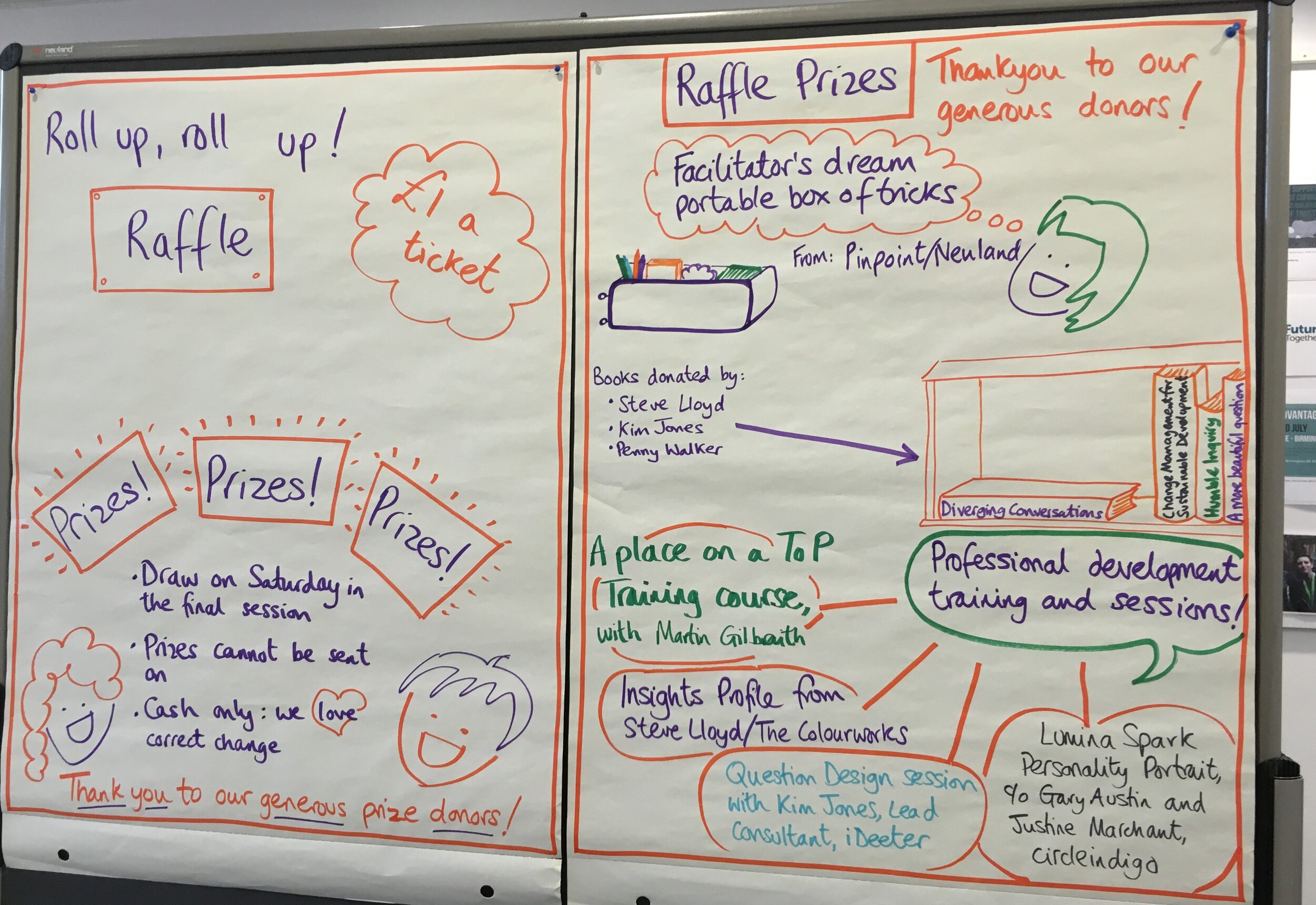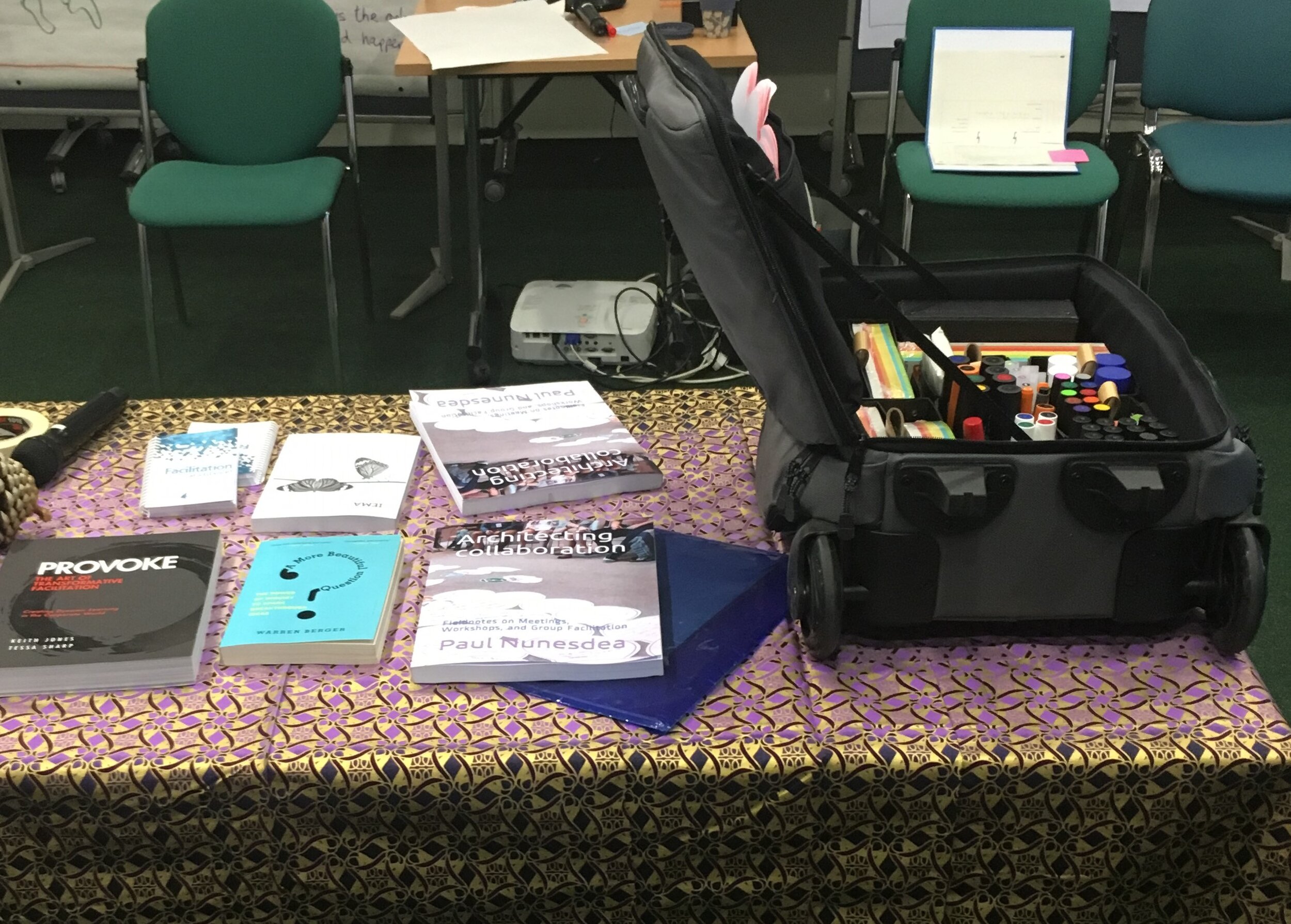Gary Austin’s beautiful welcome flip
What do you call…?
There were around 100 facilitators in one room in Birmingham earlier this month – from all parts of Great Britain, also Ireland, Belgium, Netherlands, Italy, Spain, Portugal, Canada… What is the collective noun for facilitators?
Ideas for collective noun, on Gary Austin’s Wonder Wall. (Yes, there were people other than Gary doing things.)
What do clients want?
We kicked off with a brilliant panel session featuring three clients who commission facilitation within their organisations: Jo Murphy from the Environment Agency, Andrew Chilvers of the Royal Academy of Engineering and Ian Hutchinson, Head of Water Recycling Operations in the Anglian Water @One Alliance. Jo is a pleasure to work with as a client because she really understands what facilitation can do for a group, and I’ve enjoyed working with her in various processes and situations over the years.
Insights from the client panel included
the weight clients put on recommendations for facilitators, from colleagues they trust (high),
the importance of thinking their facilitator will be a safe pair of hands,
post-it fatigue and avoiding (badly done) ‘bog standard’ facilitation,
and the huge value of the challenge and co-creation of bespoke conversations which happens before the ‘event’, and the debriefing and observations the facilitator brings after it.
Our panel stressed that external facilitators can challenge hierarchy and assumptions in a way that’s hard for internal people to do.
All of our panelists were from organisations with a strong engineering focus. I would love to explore whether and how that influences the way they use facilitators, and whether there are significant differences in other sectors. One for next year, perhaps?
In-house facilitation training
I ran a session on building in-house facilitation capacity - and it’s so much more than training people in a standard set of skills. We had a great resource in the room: nearly everyone had either commissioned or delivered in-house facilitation training and many had been part of designing and managing a network or pool of in-house facilitators. In the hour we had together, we identified all sorts of ways that facilitators can learn more about their art, and we also explored some of the critical questions for clients to think about, before embarking on a training programme – avoiding the pitfalls (e.g. facilitating meetings when your boss / senior people are in the room, what might be a challenge for these facilitators, in relation to keeping independent of the content?) and making the most of the benefits (potential for finding co-facilitators and learning buddies; potential / ease of support / learning network). I’ll blog about this at greater length some time!
IAF Professional Development
There was a lot of interest in the Certified Professional Facilitator qualification (CPF) and debates about what counts as facilitation, for that certification. Of course we use facilitative approaches in situations where we are not acting as pure process facilitators. Why wouldn’t we? The CPF specifically looks at our competence around the process facilitation role.
All kinds of other uses for facilitative approaches are informed by that practice, and people who use facilitation in all sorts of situations are welcome and already playing a big part in IAF.
For more on professional development opportunities via IAF, see here.
Screwing up safely
Facilitating the final plenary, I had a brilliant idea for a way of getting this large group into threes. Get everyone to do ‘scissors, paper, stone’ and then get together with someone who made a different sign to you, to form threes! Can you see how this might fail?
Yes. So could I, about five seconds after I’d briefed the group.
About half the people did scissors, nearly half did paper and a very select handful made a stone! It was a screw up. And everyone laughed and we all learned something. Two things, actually:
Don’t use this as a way of getting three even sized groups.
When playing ‘scissors, paper, stone’ make stones to maximise your chances of winning.
And people organized themselves into threes without any need for a fancy technique. I knew it was fine, because we all felt like a team.
Team work
At different points during the two days, other facilitators just stepped in to do what was needed: moving furniture, making flips (like this beautiful map of our Open Space spaces from Gary Austin), putting post-its on the map to show which conversation was happening where. Taking down flips at the end… of which more anon.
Map of our spaces for Open Space
We do love stationery…
When all’s said and done, we do like a bit of stationery!
There was a raffle, with lots of very generous prizes donated by facilitators, but the one everyone had their eye on was the trolley full of pens, pins and post-its from Neuland / Keith Warren-Price of Pinpoint.
…Even if we throw it away
I came face to face with very different assumptions about what happens to flip charts at the end of an event. I often reuse flip charts from one event to another. Perhaps this is part of my extreme eco sensibility, like reusing blu-tack and not doing icebreakers (out of respect for polar bears)? But I was shocked when I realised the flips I had been intending to carefully take down and roll up for future use had been scrumpled up and binned by the large team of helpful helpers. I didn’t even get to photograph the additional ideas which people had generated during the ‘in house facilitation training’ conversation. Let it go. And get in quicker next time!
Thank you!
All in all, a wonderful few days in the company of the most generous and uplifting group of people. If you want to meet other facilitators, check out the meetup groups and other ways of connecting in England, Wales, Scotland and Ireland, and all over the place.
It was a real pleasure to be a small part in a big team, which worked together so well - because of high trust and shared intent. Special thanks to IAF England & Wales stars: Martin Gilbraith, Hilary Topp, Gary Austin, Neil Fogarty, Lee Button, Helene Jewell, Steve Lloyd for great core organising, and Jet Proost over from the Netherlands for buddying up with me on the Professional Development open space session.
#iafmeetup #facweek





